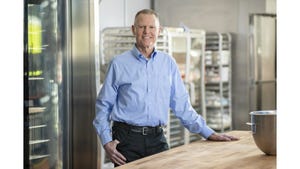Dust Collection Solution Improves Ingredient Processor's Environment, Saves Costs
August 1, 2006
|
The solution to Mulligan's dust collection challenge was an external UAS SFC 12-3 downward flow cartridge dust collector customized with a C-3600 cyclone pre-cleaner for each of the existing large mixer and batch-weighing areas. |
Essentially, a dust collector is both part of a plant's air exhaust system and its subsequent supply-air system. It captures and filters out particulate in the exhaust airflow and helps return clean air back into the facility. Because those two functions can affect the temperature and humidity of in-plant air, a dust collector must be able to do its foremost job of cleaning the air while integrating with, rather than encumbering, the facility's temperature and environmental controls. This becomes increasingly important for plants that operate a great deal of equipment in a hot, humid geographical climate and process materials that require cool, dry in-plant conditions to maintain their integrity and workability.
In a sizable area of its operations, Mulligan Sales Inc., City of Industry, CA, blends dry dairy and other food ingredients for makers of baked goods, snack foods and confections. Such powdered ingredients - especially those that add colors - create high dust levels. Most are also hygroscopic, absorbing moisture in the air, which causes lumping and other issues in processing and operations.
Like many processing facilities, Mulligan's facility requires both sufficient dust collection and constant air conditioning for temperature and humidity control. Running both of these systems simultaneously was not an option with the existing dust collection equipment: an external baghouse unit with envelope-type filters and a manual shaker for filter cleaning. As plant manager Byron Tobin explained, "We had tremendous dust challenges. The system vented outside, so there was no air-return back into our mixing and batch-weighing areas. But we could only run the air conditioning when the old dust collector was off and we weren't blending. It just wasn't working for us."
Tobin and quality assurance manager Kelley Blosser began searching for a new dust collection solution and the technical help they needed to integrate it with their environmental controls. They met with Dave Stroze of Clean Air Specialists Inc., the area representative of United Air Specialists (UAS). Stroze identified key design inefficiencies in their existing equipment, including hooding that was not providing sufficient source capture collection, and the system's inability to separate material. While discussing potential solutions, the group also considered additional areas of the facility in need of dust collection, as well as the company's potential need for additional processing equipment in the future.
Seeing is Believing
|
A view of exhaust duct from the SFC collector shows the system's in-line silencer and safety filter. |
Next came what Tobin calls "the selling point." Stroze arranged a tour of a successful UAS installation at a leading snack food maker's facility, similar to Mulligan's application. Tobin and Blosser were impressed with the dust collection performance in operations located in an even hotter regional climate than theirs, and that the plant's air conditioning could run continually. Tobin observed, "The fact that this company allowed us to check out every aspect, including the air-return system on its roof, said a great deal about their confidence in UAS' dust collection equipment."
Work began on the solution for Mulligan Sales shortly thereafter. "UAS incorporated a number of the proven technologies from the snack food facility's system in our design," Tobin noted. When UAS proposed the design for Mulligan's application and requirements, Tobin and Blosser compared it with a competitive collector to further qualify it. They determined that UAS' equipment configuration offered better features for their specific needs.
Dust Decreased by 85 Percent
The solution was an external UAS SFC 12-3 downward flow cartridge dust collector customized with a C-3600 cyclone pre-cleaner for each of the existing large mixer and batch-weighing areas. This achieved measurably more effective, efficient dust collection than Mulligan's previous baghouse unit. Tobin reports that his facility has seen a substantial reduction in airborne particulate: residual airborne dust has been decreased by 85 percent.
UAS' solution also resolves the facility's challenges of dust collection in conjunction with temperature and humidity control. As the old system would have extracted the air from the air-conditioning unit if run simultaneously, the new system does not. And unlike the previous externally vented design, the new SFC system now returns clean air into the facility. Additional features include a safety filter to allow the SFC to safely return the conditioned air back into the processing room and capture any escaped dust if ever required, and an outlet silencer after the dust collector to keep the noise level well under OSHA guidelines.
Mulligan Sales has realized further valuable savings by having a dust collector system that does not discharge air outside, as the previous system did. According to Tobin, the company is saving thousands of dollars in state permitting fees, while reinforcing its good-neighbor commitment.
Maintenance Also Reduced
|
When filters need changing, the new dust collection system's “QuickSeal” release doors allow quick, easy access. |
Mulligan's new SFC unit saves the company time and labor, as well. Tobin noted that keeping the old collector's filter bags clean was extremely labor intensive and time consuming, but the SFC can go much longer between filter change-outs. Using patented technology, the SFC "pulses" dust off the filter. The pulse-jet system cleans the full length of the cartridge filter for better, long-lasting performance. This also allows the unit to clean the filters while it is operating. Further, the pulsing is delivered in regulated "blasts" of air, so fewer pulses are needed, which conserves costly compressed air. Fewer pulse cycles also mean less stress on the filter media, which reduces the frequency of filter changes and their costs. When filters need changing, the SFC's "QuickSeal" release door allows quick, easy access.
Value-added features that Tobin also cited include UAS' washable filter cartridges with a spare set for less downtime during filter changes, explosion relief vents to help protect the collectors, and three additional flexible dust collection arms that allow reconfiguration of the processing room equipment for other projects.
In summarizing the project, Stroze said, "What makes the UAS system a more effective, efficient solution than Mulligan's previous equipment is that it is sized more appropriately for the facility's specific needs. It wasn't just a matter of providing a bigger system, but one that was a better fit. The facility had limited power that could be made available to the dust collection equipment. By tailoring the design, we could meet the equipment and airflow goals and still come in at the required horsepower."
Additionally by design, the new system's filters are more efficient — 99.8 percent at 0.5 micron - versus the old collector's efficiency of 99 percent at 1.5 microns. UAS also customized the SFC to include a cyclone pre-cleaner, as a number of the facility's products would benefit from the added cleaning advantage. The collectors themselves are powder coated for the corrosion resistance this customer needs and, unlike the old equipment, this system can be expanded.
As for accommodating future needs, Tobin says his facility is initially optimizing 30 to 40 percent of the new system's capacity. This allows for expansion or reconfiguration to improve productivity at any time. "We knew we needed to step up. Dave Stroze and UAS worked with our vision all the way. The result is impressive and we have future capability."
For processors of powdered ingredients seeking to improve dust collection — and ideally integrate that system with in-plant air conditioning and environmental controls — the relevant successes of SFC technology and UAS custom design afford a logical route to a viable solution. In addition, the inherent benefits of the technology help reduce costs ranging from those of system maintenance to applicable permitting requirements to system accommodation of a facility's operational changes and growth.
David E. Gelb is the western regional manager for United Air Specialists, Cincinnati. UAS designs and manufactures air filtration equipment for a wide range of commercial and industrial dust applications. More information is available at www.uasinc.com or by calling 800-252-4647.
About the Author(s)
You May Also Like






